TRENDnet TE100-P1U, 10-100Mbps mini Print Server, TE100-P1P User Manual 3
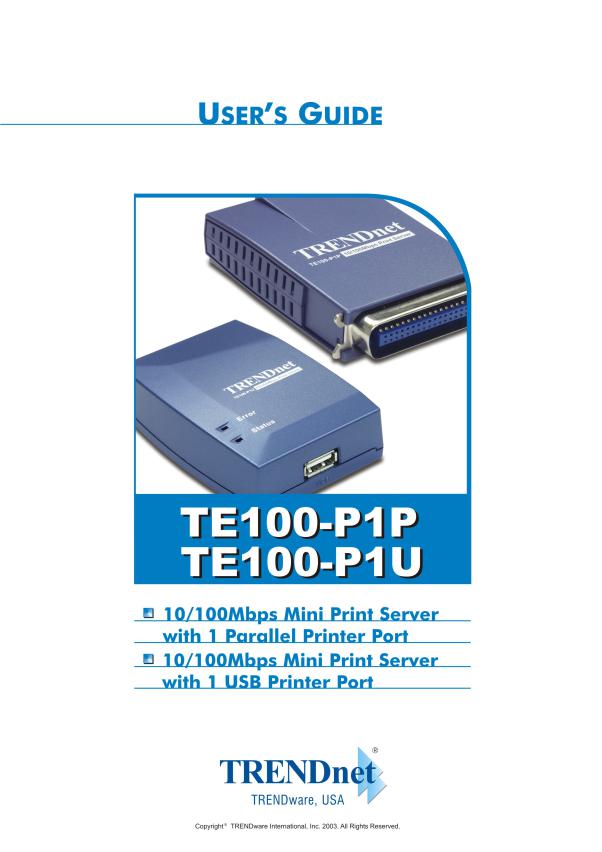

Table of Contents
Chapter 1 Introduction |
1 |
Features......................................................................................................................... |
1 |
Safety Instructions ........................................................................................................ |
2 |
Package Contents.......................................................................................................... |
3 |
Hardware Details .......................................................................................................... |
3 |
Chapter 2 LAN Installation |
6 |
Procedure...................................................................................................................... |
6 |
Chapter 3 Print Server Configuration |
7 |
Overview ...................................................................................................................... |
7 |
Using the Windows Wizard.......................................................................................... |
7 |
Chapter 4 Client PC Configuration |
9 |
Overview ...................................................................................................................... |
9 |
Windows Peer to Peer Printing................................................................................... |
11 |
Windows SMB Printing.............................................................................................. |
18 |
Windows with Server-based Print Queues ................................................................. |
20 |
Macintosh (AppleTalk)............................................................................................... |
21 |
Macintosh OS X ......................................................................................................... |
22 |
Chapter 5 BiAdmin Management Utility |
24 |
Requirements.............................................................................................................. |
24 |
Installation .................................................................................................................. |
24 |
Operation .................................................................................................................... |
24 |
Chapter 6 Web-Based Management |
34 |
Overview .................................................................................................................... |
34 |
Preparation.................................................................................................................. |
34 |
Connecting to the Print Server.................................................................................... |
35 |
Configuration Screens ................................................................................................ |
35 |
Chapter 7 Special Features |
40 |
Overview .................................................................................................................... |
40 |
Internet Printing Protocol(IPP) ................................................................................... |
40 |
Internet Mail Printing ................................................................................................. |
44 |
Chapter 8 Troubleshooting |
49 |
Overview .................................................................................................................... |
49 |
Hardware & LAN Problems ....................................................................................... |
49 |
AppleTalk (Macintosh)............................................................................................... |
50 |
Windows Printing Problems ....................................................................................... |
52 |
|
Page i |
Unix Troubleshooting................................................................................................. |
56 |
Appendix A Specifications |
57 |
General Specifications................................................................................................ |
57 |
Appendix B Windows Server Configuration |
59 |
Windows NT 4.0 Server ............................................................................................. |
59 |
Windows 2000/2003 Server ....................................................................................... |
60 |
Appendix C Unix Systems |
61 |
Overview .................................................................................................................... |
61 |
Print Server IP Address Configuration ....................................................................... |
61 |
Other Print Server Configuration................................................................................ |
61 |
LPD Printing............................................................................................................... |
62 |
Appendix D NetWare |
67 |
Overview .................................................................................................................... |
67 |
Creating an NDPS Manager Object............................................................................ |
67 |
Creating an NDPS Printer Agent................................................................................ |
68 |
Page ii
Chapter 1
Introduction
This chapter provides an overview of your Print Server's features.
Features
Congratulations on the purchase of your new Print Server. Your Print Server was designed to provide a simple and efficient network printing solution. It is packed with features, including:
Versatility. The Print Server supports up to four protocols: TCP/IP, SMB (Service Message Block), AppleTalk (EtherTalk), and NetBEUI. It features a 10/100BaseT Ethernet interface port for connection to your LAN and operating system support includes Unix, NetWare (NDPS LPR printing), and Microsoft Windows.
Easy Installation. The Print Server makes adding printers or plotters to your network simple.
Easy Setup. A number of utility programs are supplied to simplify setup. For Windows 95/98/Me/NT/2000/XP users, the BiAdmin program makes it easy to configure the Print Server for a variety of network and server configurations.
Web-based Interface. The Web-based interface provides an easy method of configuration in TCP/IP networks regardless of your operating system.
Compact Size. This allows the Print Server to be used even where space is limited.
Remote Management Tools. A variety of software tools are provided. In most environments, both the Print Server and attached bi-directional printers can be configured remotely.
Internet Printing Protocol (IPP) Support. The Print Server can act as an IPP (Internet Printing Protocol) Server, allowing clients, suppliers, colleagues and others to print to your printer from anywhere on the Internet. Windows IPP Client software is also supplied on the CD-ROM.
Page 1
Safety Instructions
For your own safety, and to protect your Print Server, please observe the following safety advice.
1.Unplug this device from its power source before cleaning. Use only a slightly dampened cloth for cleaning. Do not use liquid or aerosol cleaners.
2.Avoid using this product near water. Exposure to water poses an electric-shock hazard.
3.Do not place the Print Server on an unstable surface. The device may fall causing serious damage to the device.
4.This device should only be used with the power supply type specified on the marking label. If you are not sure of type of your local power supply, consult your dealer or the local power company.
5.Do not pinch, crimp or otherwise damage the power cord. If exposed to foot traffic, ensures that the cable is properly shielded and does not pose a tripping hazard.
6.If using an extension cord, makes sure the total ampere rating of the products using the cord does not exceed the extension cord's ampere rating.
7.Do not attempt to service this device, as opening or removing casing may expose you to dangerous voltage points or other risks. Refer all servicing to qualified service personnel.
8.The Print Server should be serviced by qualified service personnel under the following conditions:
•The power cord is damaged or frayed.
•Liquid has been spilled onto the product.
•The product has been exposed to rain or water.
•The product does not operate normally in accordance with the operating instructions.
•The device has been dropped or the casing has been damaged.
Page 2
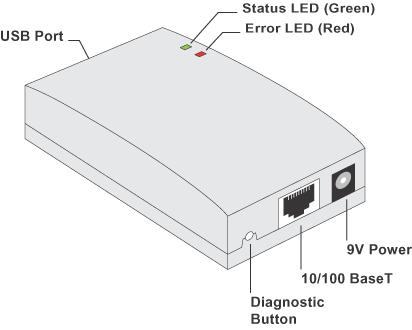
Package Contents
You should find the following items packaged with your Print Server. If any items are missing, contact your dealer immediately.
•The Print Server unit
•Power Adapter
•One CD-ROM containing all support programs and this manual
•Quick Install Guide
Hardware Details
Details of the LEDs and connections are in this Chapter. Further details are contained in
Appendix A - Specifications.
TE100-P1U Print Server
•1 USB Printer Port
•10/100BaseT LAN connection
Figure 1: TE100-P1U Print Server
Page 3
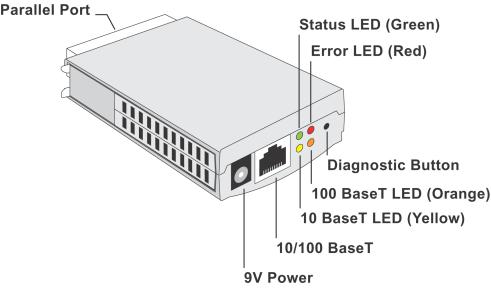
TE100-P1P Print Server
•Direct Attach
•1 Parallel Port
•10/100BaseT
Figure 2: TE100-P1P Print Server
Page 4
LED Indicators
The TE100-P1U has two LED indicators on the top; the TE100-P1P's LEDs are on the end. The Error LED is red. The Status indicator LED is green. The LED indicator modes are described in the following table.
Status LED |
Error LED |
Status Description |
(Green) |
(Red) |
|
Off |
Off |
No power. |
|
|
|
On |
Off |
Normal operation - Idle. |
|
|
|
Flashing |
Off |
Normal operation - transmitting or |
|
|
receiving packets from the network. |
|
|
|
On |
On |
Hardware error. |
|
|
|
On |
Flashing (USB only) |
No printer connected to the USB port. |
|
|
|
Flashing |
Flashing |
Firmware upgrade in progress. |
|
|
|
Diagnostic Push Button
The button is recessed; a pin or paper clip can be used to press it. This button has 2 functions:
•Restore the factory default settings
•Print a test page containing all current settings.
To restore the factory default settings:
1.Turn the Print Server OFF.
2.Press and hold the diagnostic button. While pressing the button, switch the Print Server ON.
3.If you continue pressing the button for 10 seconds, a diagnostic page will be printed, showing the new (default) settings.
To generate a Diagnostic print out
1.Ensure that both the Print Server and the attached printer are ON.
2.Press the diagnostic button, and hold it in for 2 seconds.
3.The test page, containing the current settings, will be printed.
Note:
PostScript printers are unable to print this page. If you have a PostScript printer, the test page will not be printed.
Page 5
Chapter 2
LAN Installation
This chapter describes how to install the Print Server in your Local Area Network.
Procedure
1. Preparation
• Ensure the power is OFF. Do not connect the Print Server while power is On.
• Find the Default Server Name for your Print Server. The Default Server Name is shown on a sticker on the base of the device. It consists of 8 letters and/or digits. Record this name; it may be needed during configuration.
2. Connect the Printer
• For the TE100-P1U, use the cable supplied with your printer to connect the printer to the USB port on the Print Server unit.
• For the TE100-P1P, connect the male parallel port on the Print Server directly to the printer.
3. Connect the Network Cable
• Connect the network cable to the 10/100BaseT LAN connector on the Print Server.
4. Power Up
Plug in the power adapter cable and power up. Start-up will take only a few seconds.
Use only the Power Supply unit provided with the Print Server. Using a different Power Supply may cause damage.
5. Check the LEDs
•The Error LED should flash, then turn Off. When the Error LED goes off and the Status LED remains lit or flashes, the Print Server is ready.
•On the TE100-P1P, either the 10BaseT (yellow) LED or the 100BaseT (orange) LED should be On.
•On the TE100-P1U, the Error LED will remain flashing if the Print Server can't connect to the USB printer.
Page 6
Chapter 3
Print Server Configuration
This chapter provides an overview of the configuration process.
Overview
The Print Server is designed to support many different platforms, and the configuration required would depend upon the environment in which it is installed.
•The Print Server usually requires configuration, but if there's a DHCP server on your network, then the device is just plug-and-play. A Windows-based setup Wizard is also provided on the CD-ROM to simplify this task.
•PCs wishing to use the printer attached to the Print Server always require configuration. See Chapter 4- Client Configuration for details.
•If you wish to use a queue-based printing system using Windows NT Server/Windows 2000/Windows XP, the Network Server must be configured as detailed in Appendix B - Windows Server Configuration. However, it is not necessary to use a Network Serverbased queue; client PCs can print directly to the Print Server using the Peer-to-peer Printing installed by the User setup option on the CD-ROM.
Configuration Methods
The following methods are available to perform the required Print Server configuration:
•Windows-based Wizard - see below for details.
•BiAdmin management utility program - see Chapter 8 for details.
•Web-based setup - see Chapter 6 for details.
Advanced Configuration and Management
The BiAdmin management utility is provided for advanced configuration and management. This program is installed by default when the Administrator install option is chosen. See Chapter 5 for details on using BiAdmin.
Using the Windows Wizard
The Windows-based Wizard is supplied on the CD-ROM, and runs on Windows 95, 98, NT4.0, ME, Windows 2000 and Windows XP.
Using this Wizard is the recommended method to configure the Print Server.
It can be used configure the Print Server for your Network environment, even if the Print Server does not have a valid IP address.
Procedure
1.Insert the supplied CD-ROM into your drive. If the setup program does not start automatically, run SETUP.exe in the root folder.
2.On the first screen, shown below, click Setup Wizard.
Page 7
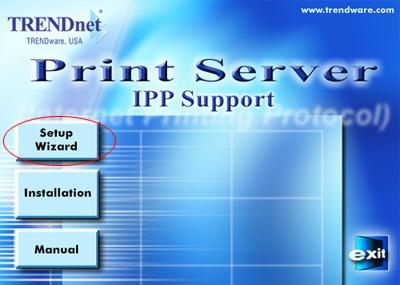
Figure 3: Print Server Screen
3.Click Next on the first screen of the Wizard, to view a list of Print Servers on your LAN.
4.Select your new Print Server, then click Next to continue.
5.Enter the required data on the following screen.
•Name of the Print Server can be changed if you wish.
•Comment is optional.
•Select or enter the Workgroup name for this Print Server.
6.Click Next to configure the TCP/IP Screen:
•Select Obtain IP Address automatically if your LAN has a DHCP Server, otherwise select Fixed IP Address.
•For Fixed IP Address, enter an unused address from the range used on your LAN, or click the Suggest New Values Button.
Use the same Network Mask and Gateway as PCs on your LAN.
7.Click Finish to save the data to the Print Server.
Note: To install the Wizard on your PC, use the "Installation" option.
If the desired Print Server is not listed:
•Check all cables to the Print Server.
•Check the Print Server's LEDs:
The Red LED should be OFF and the Green LED should be ON or flashing.
Page 8
Chapter 4
Client PC Configuration
The chapter details the client configuration required on LAN clients to use the printer or printers attached to the Print Server.
Overview
Before performing client configuration, the Print Server must be installed on your LAN, and configured as described in Chapter 3. Both the Print Server and the attached printer must be powered ON.
Printing Methods
The Print Server supports a number of printing methods:
•Peer-to-peer Printing means that the print jobs are stored (queued) on your PC, and sent directly to the Print Server when it is available.
•Server-based Print Queue means that all print jobs are stored (queued) on the Network Server (e.g. Windows NT/2000) and then sent to the Print Server. This allows the Network Administrator to modify the Print Queue. For example, an important job can be moved to the head of the queue.
•Windows SMB printing is a Microsoft standard for using a "Network Printer". No additional software needs to be installed on your Windows PC, and printing from MSDOS programs is supported. However, because the Print Server can not store files, large print jobs may cause problems.
•AppleTalk is also supported, and normally no configuration of the Print Server is required. See the Macintosh section of this chapter for details of client configuration.
Which printing method should I use?
•If using Windows 95, 98, NT, Me, 2000, or XP, the easiest method to use is Peer-to-peer Printing.
•If using Windows, and you need to print from MS-DOS programs, or you don't wish to install additional software, use SMB.
However, SMB is not suitable for large, complex documents, so if you need this as well as MS-DOS printing, you should install BOTH Peer-to-peer Printing and SMB printing. MSDOS programs can use the SMB printer, Windows programs should use Peer-to-peer Printing.
•If your LAN has Network Servers (e.g. Windows NT, Windows 2000 Server) use the method advised by your Network Administrator. The Print Server can print via a queue located on a Network server, if desired.
•Unix users - refer to Appendix C - Unix Systems
•Macintosh users - refer to the Macintosh section of this chapter.
Page 9
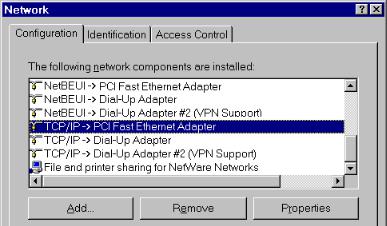
Checking your Network Protocols (Windows 9x)
Your PC must have EITHER the TCP/IP or NetBEUI protocols installed. (All versions of Windows after Windows 95 have TCP/IP installed by default.)
•If using the Peer-to-peer Printing, the installation program will check this for you.
•If using other methods, you must check manually, as follows:
1.Select the Settings - Control Panel - Network option on the Start Menu. You should see a screen like the one following:
Figure 4: Network Configuration
•The top line in the list (NetBEUI -> PCI Fast Ethernet Adapter) indicates that the NetBEUI protocol is installed on this PC. Your PC will show the name of the your Network card rather than "PCI Fast Ethernet Adapter".
•The highlighted line (TCP/IP -> PCI Fast Ethernet Adapter) indicates that TCP/IP is installed. Your PC will show the name of the your Network card rather than "PCI Fast Ethernet Adapter".
2.If neither line is present:
•Install the NetBEUI protocol by selecting Add - Protocol - Microsoft - NetBEUI - OK. You may be prompted for your Windows CD-ROM.
•If required, you can also install TCP/IP. However, depending on your LAN environment, TCP/IP may require further configuration.
3.If either protocol is already installed, proceed with installation.
Page 10
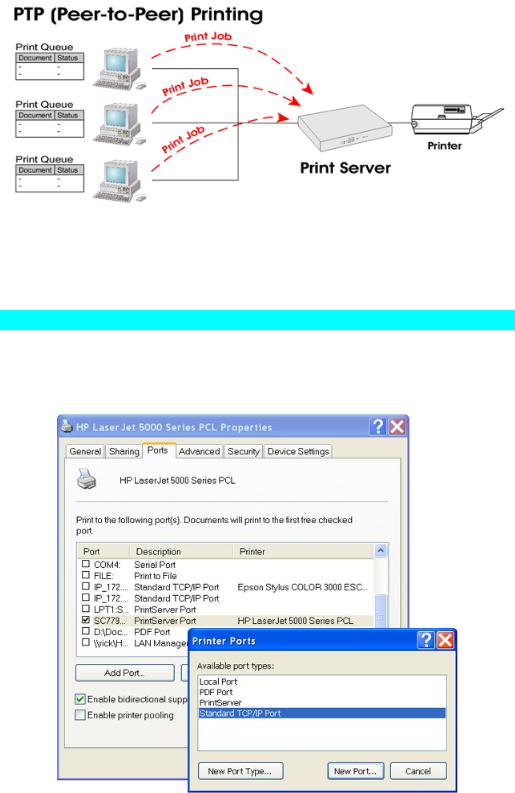
Windows Peer to Peer Printing
With this printing method, print jobs are stored (queued) on your PC, and then sent to the Print Server when it is available.
Figure 5: Peer-to-Peer Printing
Windows 2000 & XP require no additional software.
For other versions of Windows, the supplied PTP (Peer-to-Peer) Printer Port software must be installed on each PC.
Windows 2000/XP Setup
The recommended printing method is to use LPR, as follows:
1.Open your Printers folder, right-click the desired printer and select Properties.
2.When prompted, choose the Ports tab and click the Add Port button.
Figure 6: Printer Ports Screen
Page 11
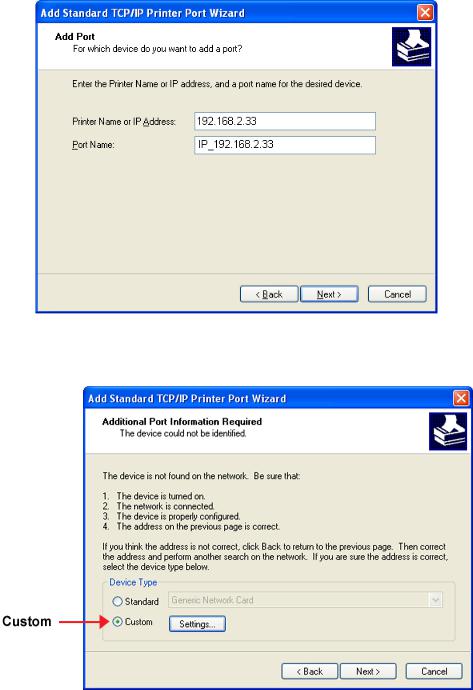
3.Choose Standard TCP/IP Port, then click New Port.
Figure 7: Add Port Screen
4.On the Add Standard TCP/IP Printer Port screen above, enter the IP Address of the Print Server in the Printer Name or IP Address field, then click Next.
Figure 8: Additional Port Information Screen
5.On this screen, select Custom, and click the Settings button to view the screen below.
Page 12
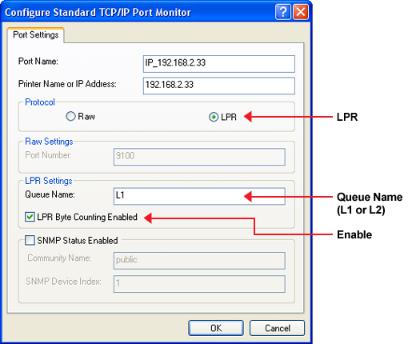
Figure 9: Port Settings Screen
6.On the Port Settings screen, shown above:
•Select LPR in the Protocol section
•Enter a Queue name (L1 for Port 1, L2 for Port 2 if the Print Server has 2 printer ports)
•Ensure the LPR Byte Counting Enabled setting is Enabled.
•Click OK to confirm your changes and close this screen.
7.Follow the prompts to complete the Wizard.
Page 13

Windows 9x/ME Setup
Before performing the following procedure, the Print Server must be installed on your LAN, and configured as described in Chapter 3. Both the Print Server and the attached printer should be powered ON.
1.Insert the supplied CD-ROM into your drive. If the setup program does not start, run SETUP.exe in the root folder.
2.Click the Installation button, then select the User Install.
Figure 10: Installation Screen
3.Follow the prompts to complete the installation of the Peer-to-peer Printer Port Driver. (Refer to the Windows section of Chapter 8 - Troubleshooting if there is a problem with the installation.)
4.The Print Driver Setup will then run.
In future, you can use Start - Programs - PrintServer Driver - Printer Port Setup to run the program again.
PTP Printer Port Setup
1.The program will search for Printer Servers on the network, and a screen like the following will be displayed.
•If desired, click Refresh.
•The name of the attached printer will be displayed if possible. If "No printer" is displayed, check that the printer is properly connected and powered on.
Page 14
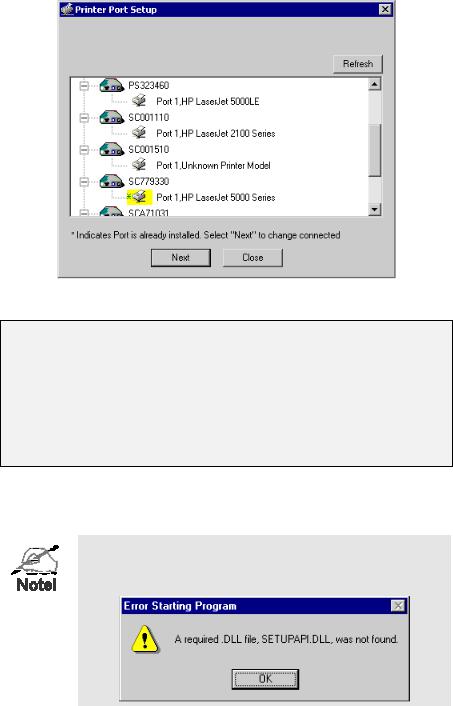
Figure 11: Print Port Setup (Peer-to-peer Printing)
If your Print Server is not listed:
•Click the "Refresh" button.
•Check that both the Print Server and the printer are properly connected, and powered on.
•Check that the Print Server has been configured. (Use the Setup Wizard on the CD-ROM.)
•If using TCP/IP, try installing the NetBEUI protocol. Then try again.
2.Select the desired port on a Print Server, then click Next. A pop-up message will inform you if the port has been created successfully.
If you see the following error message, either install Internet
Explorer 4 or later, or follow the procedure in the "Trouble
Shooting - Windows" section of Chapter 8.
Page 15
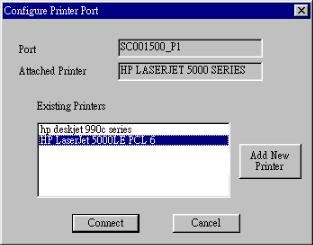
3.The printer port will be created, then a screen like the following will be displayed.
Figure 12: Configure Printer Port
4.Select the correct Windows printer in the Existing Printers list, and click the Connect button.
If the correct printer type is not listed, click "Add New Printer" to run the Windows Add Printer wizard. Step through the Wizard and install the required printer:
•Select the correct Printer Manufacturer and Model, or use the "Have Disk" option if appropriate.
•We recommend changing the Printer name to indicate which device is on. (e.g. HP2100 on SCA43600_P1)
•If prompted about Sharing the printer, do NOT enable Sharing.
•When the Printer installation is finished, it will be listed in the Configure Printer Port screen above. Select it and click Connect.
5.Installation is now complete. You can now print using this printer.
•To install additional Printers, repeat steps 4.
•Use the Start menu to run this program in future. The default installation is Start - Programs - PrintServer Driver - Print Driver Setup.
Note:
If using the Epson Spooler Manager, this program must be disabled, as follows:
1.Run the Epson Spooler Manager.
2.Select "Queue Setup" from the menu.
3.Click "Use Print Manager for this port".
4.Click "OK" to exit.
Management
•Print jobs can be managed like any Windows printer. Open the Printers folder (Start - Settings - Printers) and double-click any printer to see the current print jobs.
•If the printer attached to the Print Server is changed, just run this program again, and select the correct printer.
•To delete a port created by this setup program, use the Windows Delete Port facility:
• Right-click any printer in the Printers folder, and select Properties.
Page 16
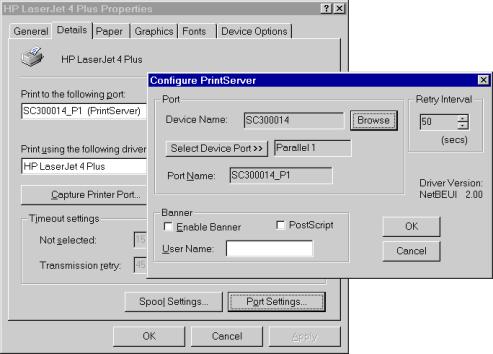
•Locate the Delete Port button. This button is on the Details or Ports tab, depending on your version or Windows.
•If the Print Server's IP Address is changed, and you can no longer print, delete the port (see procedure above) and re-install it.
Advanced Port Options
The options for the Peer-to-peer Printing are accessed via the Port Settings button.
Use Start - Settings - Printers to open the Printers folder, then right-click the Printer, and select Properties. The Port Settings button is on the Details or Ports tab, depending on your version of Windows.
An example screen is shown below:
|
|
Figure 13: Port Settings (Peer-to-peer Driver) |
Items shown on this screen are as follows: |
||
|
|
|
|
Port |
If desired, click Browse to select a different Print Server. If the selected |
|
|
device has multiple ports, the Select Device Port button can be used to |
|
|
select the port. |
|
|
The Port Name can not be changed after installation. This name is |
|
|
shown in the Printer's Properties. |
|
|
|
|
Banner |
Check this option to print a banner page before each print job. |
|
|
• If using a PostScript Printer, check the PostScript box. |
|
|
• The User Name will be printed on the banner page. |
|
|
|
|
Retry Interval |
Sets how often Windows will poll the Print Server to establish a |
|
|
connection when the printer is busy. Increase this value if you get too |
|
|
many warning messages. |
|
|
|
Page 17
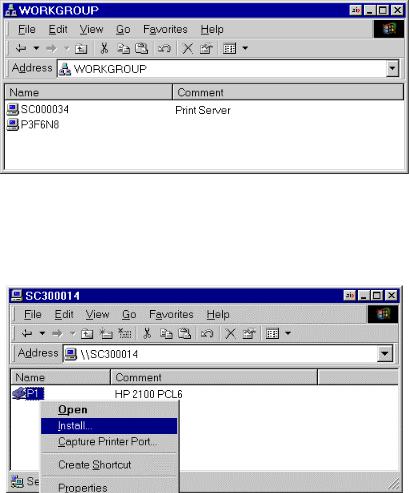
Windows SMB Printing
This method requires no additional software to be installed, but the NetBEUI or TCP/IP protocol must be installed on your PC. Use the following procedure to install the Print Server's printer as a Windows SMB network printer:
1.Double-click the Network Neighborhood icon on the desktop.
2.On the View menu, select Details.
3.Locate the desired Print Server, as shown below:
•If it is the same Workgroup as your PC, it will be listed on screen.
•If it is in a different workgroup, double-click Entire Network, then double-click the appropriate Workgroup to open it.
Figure 14: Network Neighborhood
4.Double-click the Print Server icon to view a Printer icon for each printer port. The "Comment" field may indicate what type of printer is connected to the port.
5.To install a printer, right-click the desired printer icon, and choose "Install", as shown below. This will start the Add Printer wizard.
Figure 15: Install SMB Printer
6.Follow the prompts to complete the installation.
•For information about the question "Do you print from MS-DOS programs?", see
Printing from MS-DOS Programs below.
•Select the Printer Manufacturer and Model to match the printer connected to this port on the Print Server, and complete the Wizard.
7.This printer will now appear in your Printers folder (Start - Settings - Printers) and can be used like any other printer. However, SMB printing is not suitable for large complex print jobs - you should use the Peer-to-peer Printing instead.
Page 18
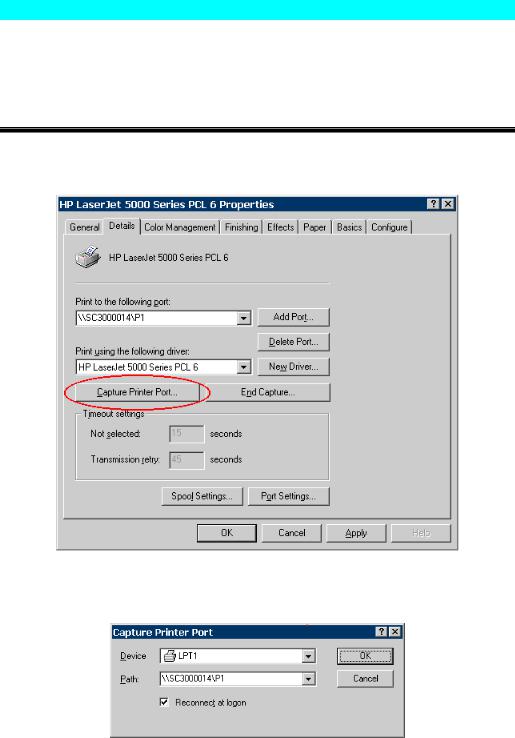
Printing from MS-DOS Programs
Windows can redirect print data from a parallel port on your PC (e.g. LPT1) to a network printer. This redirection is called "Capture Printer Port", and is useful for MS-DOS programs. The MS-DOS program is configured to use LPT1 (parallel port 1 on the PC), but Windows "captures" the print data and sends it to the network printer.
Capture Settings - Windows 98/ME
1.Select Start - Settings - Printers to open the Printers folder.
2.Right-click the desired Printer, and select Properties,
Figure 16: Capture Printer Port - Windows 98/ME
3.On the Details tab, shown above, click the Capture Printer Port button to view the Capture Printer Port dialog, as shown below.
Figure 17: Capture Dialog - Windows 98/ME
4.On this dialog:
•Select the Device (port) on the PC to be captured. Normally, this will be LPT1 (parallel port 1).
•Enter or select the Path to the printer. This will be the same as the path shown as Print to the following port on the Printer Properties window.
•Check the Reconnect at logon checkbox. If this is not done, the capture setting will be lost when Windows is restarted.
Page 19
